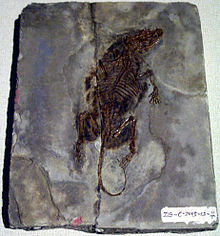| Zhangheotherium Temporal range: Early Cretaceous,
| |
|---|---|

| |
| Fossil specimen, Hong Kong Science Museum | |
| Scientific classification | |
| Domain: | Eukaryota |
| Kingdom: | Animalia |
| Phylum: | Chordata |
| Class: | Mammalia |
| Order: | †Symmetrodonta |
| Family: | †Zhangheotheriidae |
| Genus: | †Zhangheotherium Hu, Y.Q. Wang, Luo & C.K. Li, 1997 |
| Type species | |
| †Zhangheotherium quinquecuspidens Hu, Wang, Luo & Li, 1997
| |
Zhangheotherium is an extinct genus of "symmetrodont" mammal from the Early Cretaceous of China. A single species is known, Zhangheotherium quinquecuspidens from Jianshangou Beds of the Yixian Formation. Zhangheotherium was the first "symmetrodont" known from a nearly complete skeleton, expanding knowledge of the group beyond isolated teeth and jaws. The genus name honors Zhang He, who collected the holotype fossil from Liaoning Province prior to its 1997 description. The specific name is Latin for "five-cusped teeth".[1]
"Symmetrodonts" and other archaic mammals such as multituberculates and monotremes are still being debated on their taxonomical relationships. Zhangheotherium provided insight into the evolution of "symmetrodonts", revealing a combination of traits similar to modern therians (such as placentals and marsupials) as well as more "primitive" mammalians. Most likely, "symmetrodonts" are a grade of stem-group therians, with representatives incrementally closer to true therians than to monotremes.[1]
- ^ a b Hu, Yaoming; Wang, Yuanqing; Luo, Zhexi; Li, Chuankui (1997). "A new symmetrodont mammal from China and its implications for mammalian evolution". Nature. 390 (6656): 137–142. doi:10.1038/36505. ISSN 1476-4687.